The billionaire class is larger than ever. In 2023, the global billionaire population surged by 4%, reaching a record-breaking 3,323 individuals. But who exactly are individuals, and what makes them tick? Notably, 431 of them are women. While they are still a minority, this signals a significant shift in the wealth landscape. As the number wealthy of female billionaires rises, it’s crucial for organizations catering to the wealthy to understand the distinct dynamics between male and female billionaires and the unique opportunities that lie within.
Male vs female billionaires
When we look at the demographics of male and female billionaires, there are clear similarities, yet also notable distinctions. The median age for female billionaires is 67, just slightly younger than the male cohort. Both men and women in this elite group are predominantly between the ages of 50 and 70.
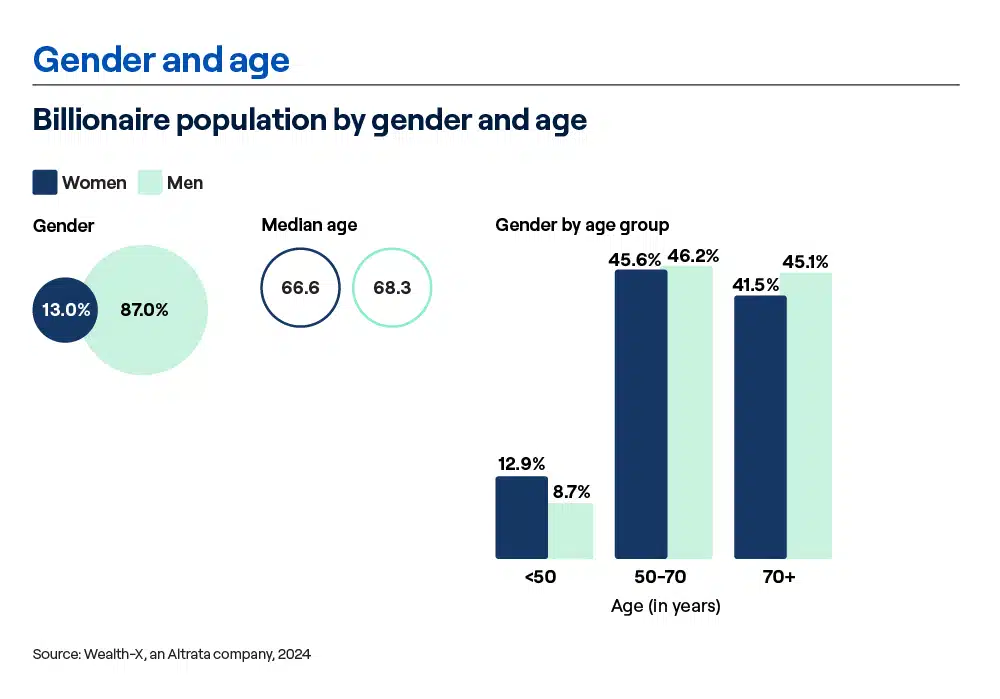
However, when we dive into the origins of their wealth, the gender gap becomes strikingly apparent. A significant three-quarters of female billionaires have inherited at least a portion of their fortune, compared to just a third of their male peers.
This trend is even more pronounced among those whose fortunes are entirely inherited. Nearly 38% of female billionaires, including some of the wealthiest women in the world—like Françoise Bettencourt Meyers, Alice Walton, and Jacqueline Mars—attribute their wealth entirely to inheritance. In contrast, a mere 5% of male billionaires have solely inherited fortunes.
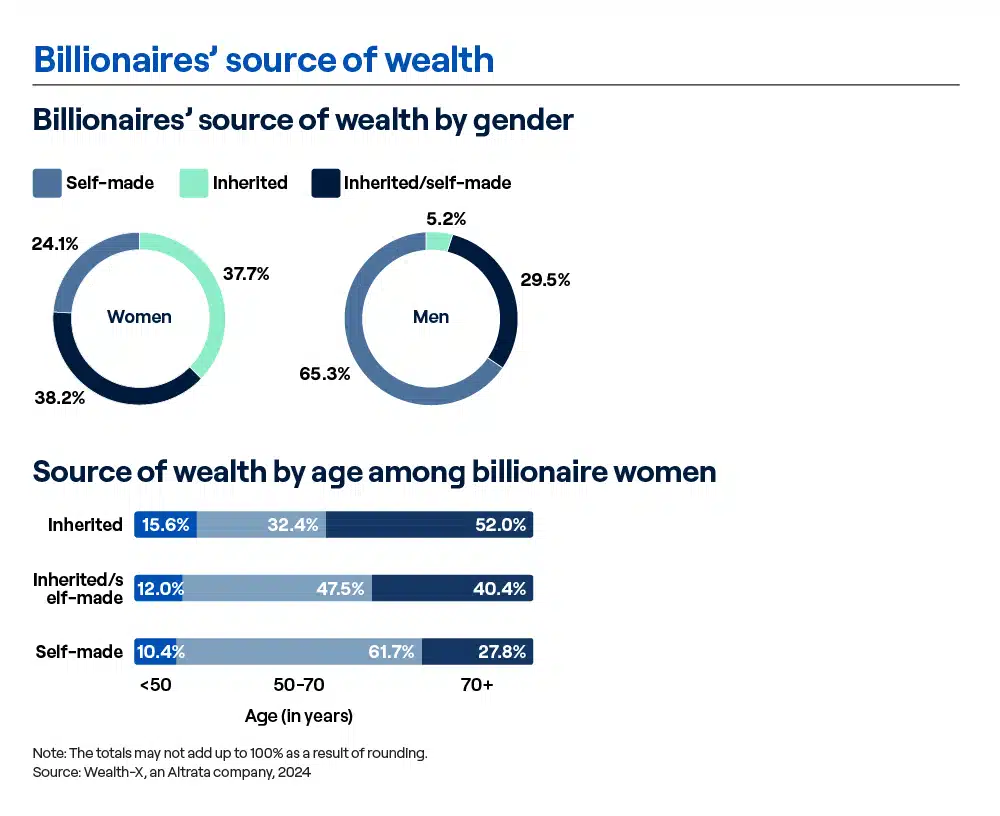
Beyond the source of their wealth, there are also key differences in the areas of focus for each gender. Female billionaires tend to be more involved in philanthropy, with nearly 20% dedicating the core of their professional time to non-profit and social causes, compared to just 5% of their male counterparts.
This passion for social impact can be partly linked to the high percentage of female billionaires who inherit their wealth. Inherited wealth often comes with a sense of responsibility, driving inheritors to engage more deeply in causes while also fostering a strong connection to social justice and welfare efforts. For billionaire women, causes related to the arts, the environment, and children are slightly more popular than with male billionaires.
Outside of philanthropic endeavors, female billionaires also have a penchant for the finer things in life, including luxury property and valuable art. Compared with their male counterparts, billionaire women are one-and-a-half times more likely to own high-end real estate and 1.3 times more likely to own valuable art.
Compared with their male counterparts, billionaire women are one-and-a-half times more likely to own high-end real estate and 1.3 times more likely to own valuable art.
The rise of self-made female billionaires
Within the expanding group of female billionaires, there’s a particularly powerful subset making waves: the self-made female billionaires. These women are not just redefining the wealth landscape – they are culturally and economically reshaping it.
Traditionally, inheritance has been the dominant path to wealth for billionaire women, but today, the rise of self-made female billionaires is shifting the narrative. This transformation is not only altering how wealth is distributed but also opening up fresh opportunities for engagement. For organizations targeting the world’s wealthiest, these women represent untapped potential and a chance to connect with a rapidly emerging force in global business.
Understanding and connecting with this exceptional group requires more than just surface-level insights. To form lasting, meaningful relationships, it’s essential to uncover what sets them apart.
What drives this group of women? Altrata’s solution, Wealth-X, offers an unparallel look at the world’s billionaire population, providing detailed and up-to-date intelligence on the wealthy across the globe. Explore their demographics, industries of focus, and top interests to reveal the key factors that motivate and influence their decisions.
For organizations targeting the world’s wealthiest, these women represent untapped potential and a chance to connect with a rapidly emerging force in global business.
Meet the world’s self-made female billionaires
The share of female billionaires has risen gradually over the past decade, as economic and societal trends have led to new opportunities for accelerated wealth creation among entrepreneurial women, but only a quarter of these women are those with self-created fortunes, according to Altrata’s Billionaire Census 2024. As previously mentioned, the other portion of these women inherited some or all of their wealth.
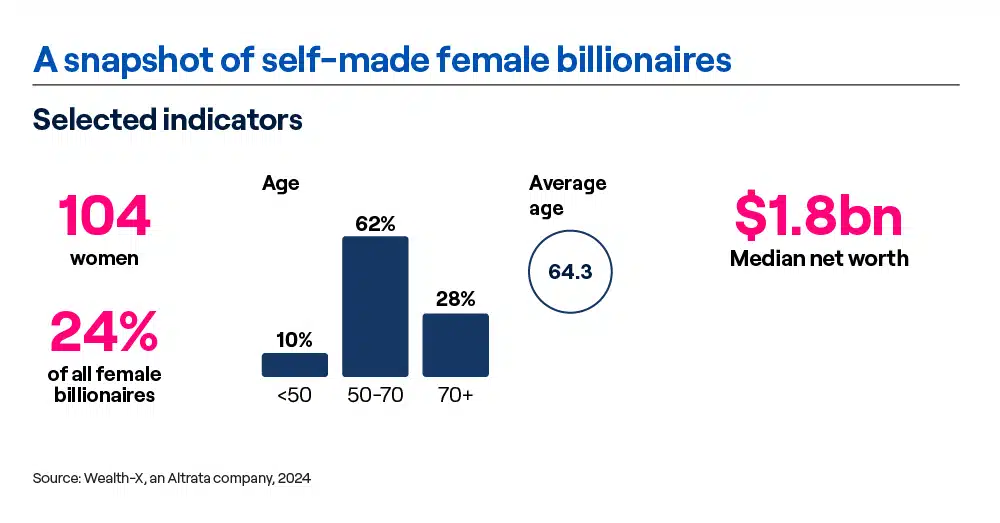
Relative newcomers to the self-made female billionaires’ club include US music artist Taylor Swift and Australian software designer Melanie Perkins, who join more established figures such as India’s Kiran Mazumdar-Shaw (biopharmaceuticals) and Diane Hendricks (the richest self-made woman in the US).
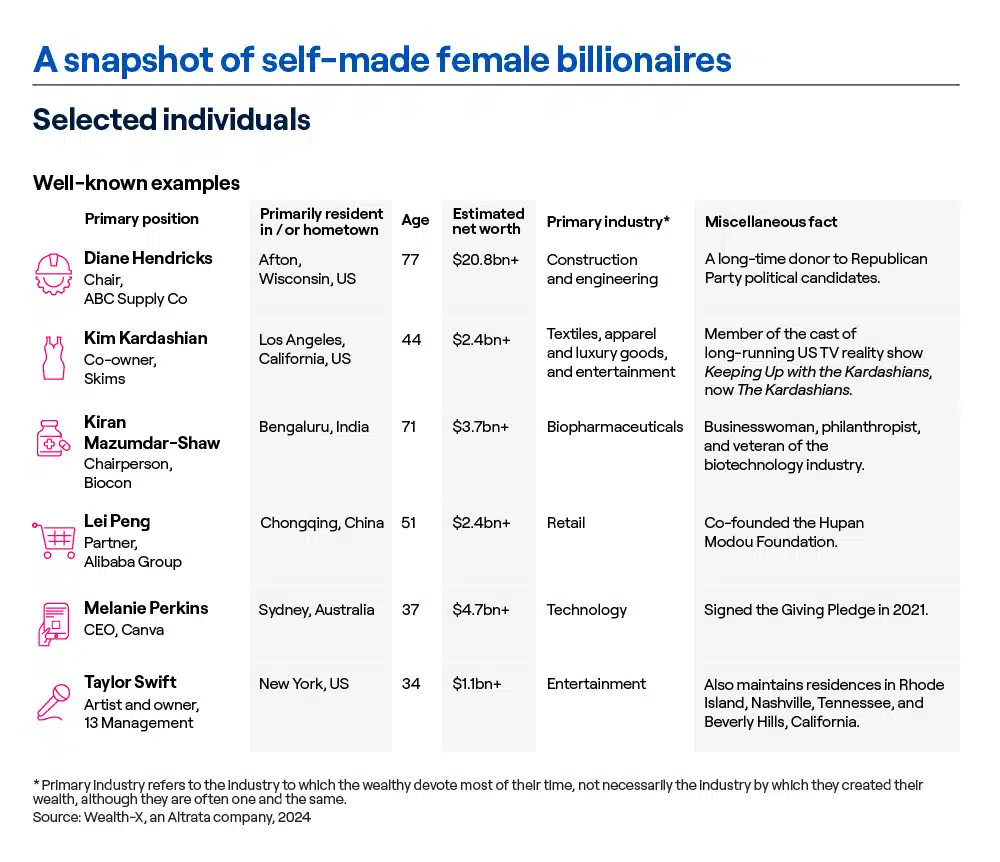
Estimated net worth amounts are based off of Altrata’s 2024 Billionaire Census data and reflect a single moment in time. These amounts may change over time depending on a variety of factors including share price fluctuations, business ownership changes and luxury asset acquisition.
Self-made women tend to be younger than heiresses
The average age of self-made female billionaires is 64 — younger than the broader female billionaire class and far younger than those who inherited their wealth. While just one in 10 self-made women are under the age of 50, the age distribution reveals a striking contrast when it comes to those over 70. More than half of billionaire heiresses fall into this category, compared to only a quarter of the self-made women, highlighting a generational shift that underscores the growing prominence of women who have built their fortunes from the ground up.
Their primary business focus is financial services, followed by technology
The primary industries that dominate among self-made female billionaires are banking and finance and technology – industries that also top the list for their male counterparts. But this shared focus becomes even more interesting when we compare it to the broader female billionaire population.
While most female billionaires are deeply involved in non-profit and social causes, technology and commercial ventures take a backseat. For self-made women, the balance shifts. Their fortunes are often built in industries where they carry leading commercial responsibilities, leaving them with less time for philanthropy early on in their careers.
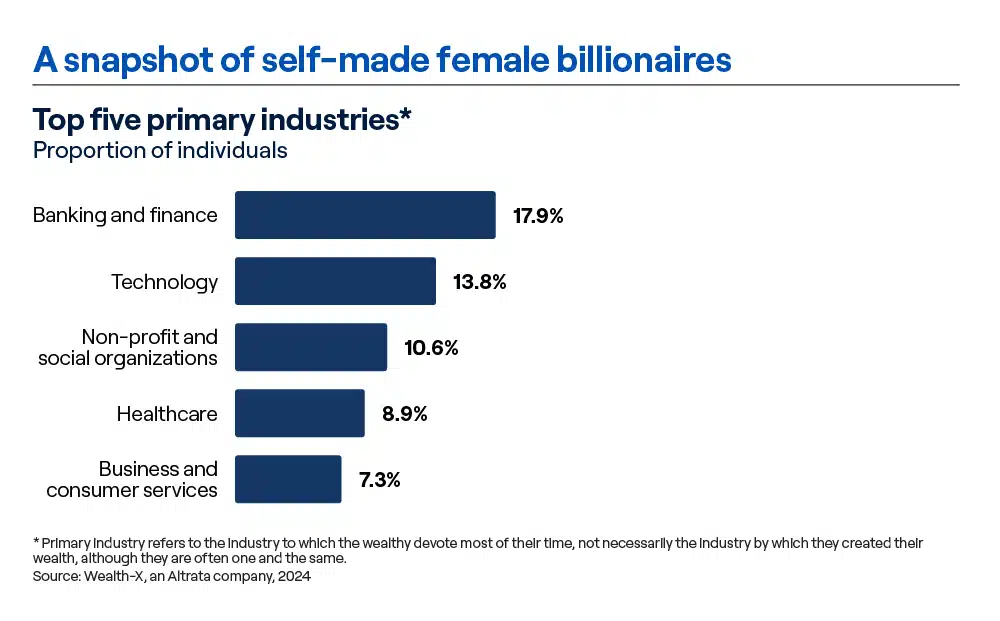
However, as they accumulate wealth, many of these self-made women expand their influence and time into other sectors, including charity and social justice, later in life. This is a unique distinction about self-made women in the billionaire class, where business acumen and commercial success often come before—though not necessarily instead of—philanthropic pursuits.
What are self-made female billionaires passionate about?
Today’s self-made female billionaires have something significant in common with the rest of their female billionaire cohort: their affinity for philanthropy. Philanthropy is the preferred interest/passion by far for female self-made billionaires; it is almost twice as popular as sports is as an interest or hobby.
It’s not surprising that technology also ranks highly as an interest among this group, above both aviation and art.
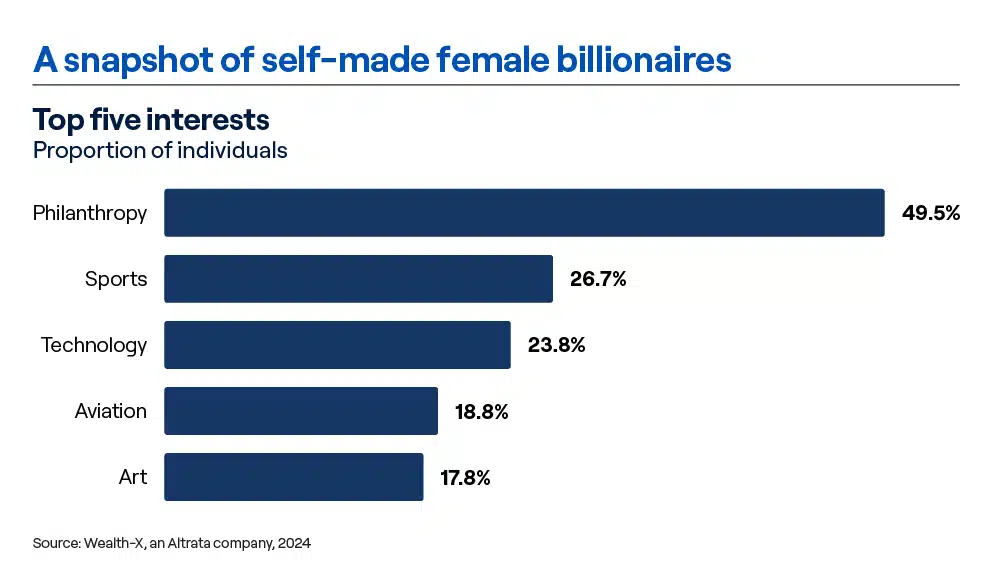
The power of personalized outreach
Curious how the rest of today’s billionaire population measures up? Unlock even more exclusive insights in the Altrata Billionaire Census 2024, which offers an in-depth look at the trends, regions, and economic forces shaping billionaire wealth across the globe.
To effectively engage today’s self-made women billionaires, it’s essential to understand them not just through the lens of their wealth, but in the context of their distinct peer group. By uncovering their unique interests and passions, organizations can create highly personalized outreach strategies that resonate on a deeper level, strengthening relationships and driving greater engagement.
If you’re ready to build stronger connections with this influential audience, Altrata can help you get there. With our advanced CRM integrations, database screenings, and cutting-edge relationship mapping capabilities, we empower you to build customized outreach strategies with ease.
Finding new ways to engage the exceptional can start today.
Find out how by booking your team’s personalized demo now.
Maya Imberg is Head of Thought Leadership and Analytics at Altrata. She is responsible for spearheading the company’s thought leadership efforts and overseeing its analytics and predictive modeling services commissioned by clients. She joined Wealth-X in 2016 as Director of Custom Research responsible for secondary research, data analytics and branded content. Maya has over fifteen years of experience in research, spanning market research, macroeconomics and financial services. Prior to joining Wealth-X, Maya held a variety of consultant and economist roles at the Economist Intelligence Unit and spent a number of years working for Datamonitor’s Financial Services practice. Maya holds an undergraduate and MSc degree in economics and comparative politics from the University of Pennsylvania and London School of Economics respectively.